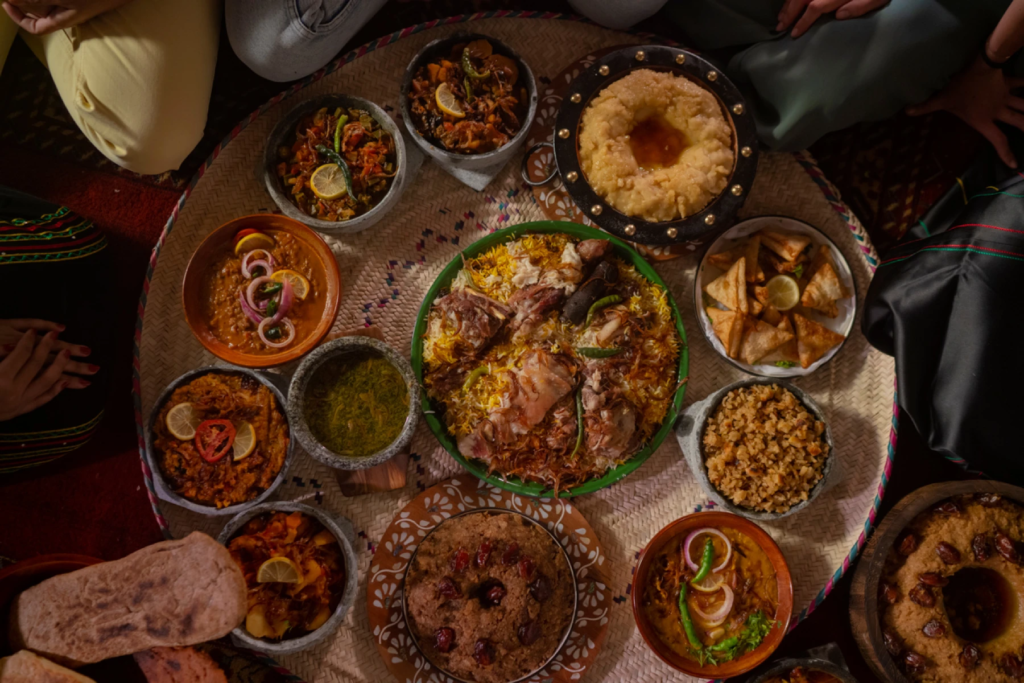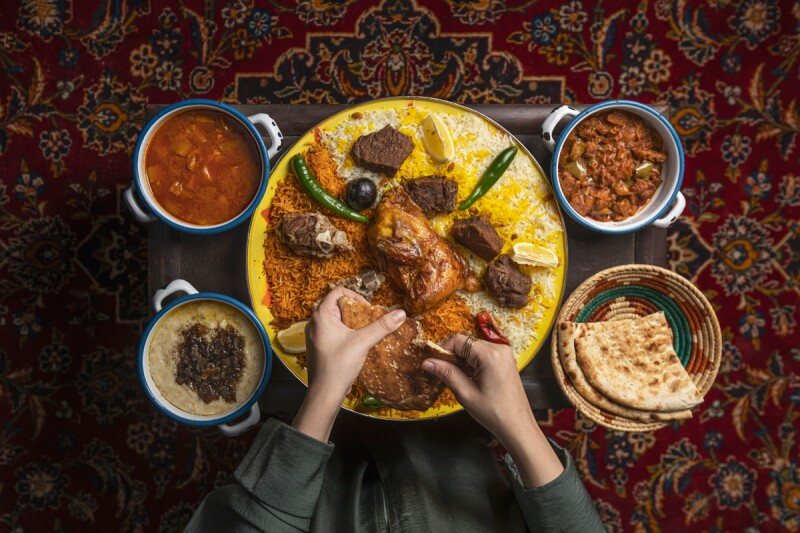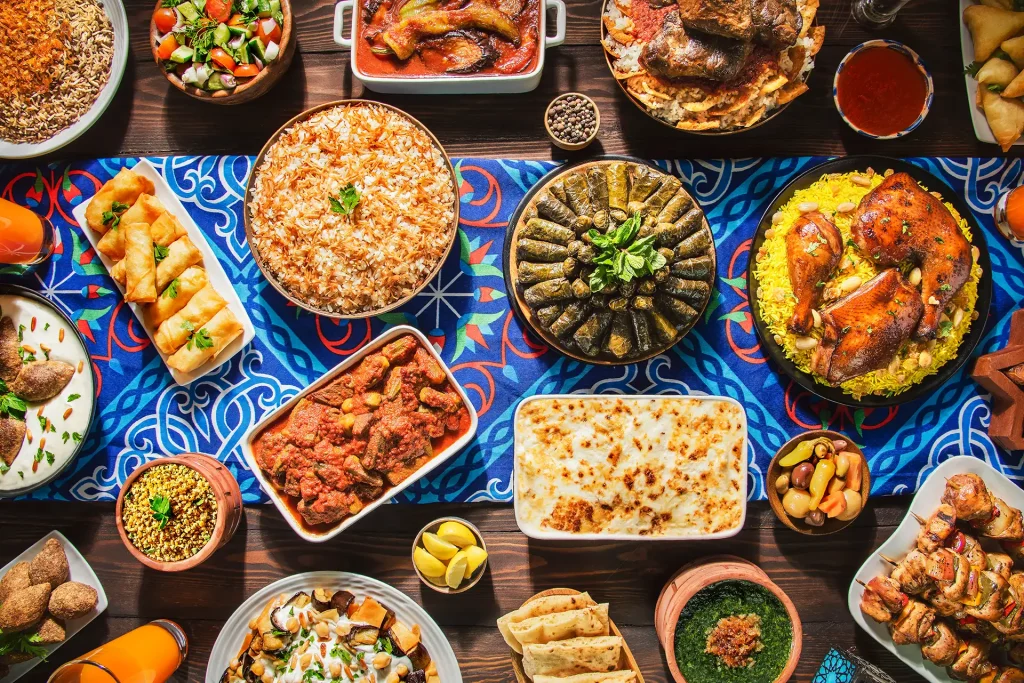Saudi Arabia is not only famous for its rich culture and religious significance but also for its regional food varieties that reflect the country’s diverse geography and traditions. From the coastal cities to the central deserts and mountain villages, each region in Saudi Arabia offers something special to the plate.
This guide to regional food varieties across Saudi Arabia will take you on a culinary journey, helping you understand the unique tastes, ingredients, and cooking methods that define the Kingdom’s food heritage.
Northern Delights: Hearty and Warming Dishes

The northern regions of Saudi Arabia, especially areas like Al-Jouf and Tabuk, are known for their cold winters and hearty meals.
Al-Margoog is a dish that stands out in this region. Made with wheat dough, vegetables, and lamb meat, it’s a slow-cooked, thick stew that provides warmth and nutrition during colder months.
Another local favorite is Al-Matazeez, which includes small pieces of dough cooked with meat and vegetables in a tomato-based sauce. These dishes are prepared in large pots and shared among families and guests, emphasizing hospitality and togetherness.
Central Saudi Arabia: The Heartland of Traditional Cuisine
Riyadh and the central Najd region are famous for their age-old recipes passed down through generations.
Kabsa, the national dish of Saudi Arabia, originated in this region. It’s a vibrant rice dish cooked with lamb or chicken, mixed with fragrant spices like cloves, cinnamon, black lime, and cardamom. It is typically served on large platters during social gatherings.
Another popular central dish is Jareesh, made from crushed wheat and sometimes mixed with milk or meat. This porridge-like meal is simple but flavorful, symbolizing the region’s historic Bedouin lifestyle.
These central dishes are rich in spices and often include ingredients that can withstand the desert climate, such as dried limes and preserved vegetables.
The Southern Mountains: A Taste of the Highlands
The Asir and Jazan regions in southern Saudi Arabia are known for their green mountains and unique agricultural products, which influence their food.
Areekah is a traditional dish made from ground wheat, dates, and ghee (clarified butter). It is mashed together and usually served during breakfast or festive occasions.
Maqshush is another favorite – it’s made from millet and topped with honey, ghee, and dates, providing a sweet and energy-rich meal.
Jazan also offers fish-based dishes, thanks to its location near the Red Sea. Freshly grilled or fried fish is often seasoned with a blend of chili and garlic, making the southern flavors more intense and spicy compared to other regions.
Western Region: The Influence of Pilgrims and Trade
Makkah, Madinah, and Jeddah form the western region, which has long been a hub for international trade and pilgrimage. The food here reflects a blend of cultures including Egyptian, Yemeni, Indian, and Turkish influences.
Saleeg is a popular Hijazi dish – a creamy rice porridge made with milk and served with grilled chicken. It’s simple yet deeply satisfying.
Another dish commonly found in this region is Mutabbaq, a stuffed pancake filled with minced meat, onions, and spices. It’s a popular street food item especially during Ramadan.
Due to its diverse population, this region is home to a wide variety of dishes, and fusion cuisines are commonly found in local restaurants and homes alike.
Eastern Province: Seafood and Coastal Flavors
The Eastern Province, including cities like Dammam, Al Khobar, and Al Ahsa, is influenced by its proximity to the Arabian Gulf.
Seafood dominates the diet here. Sayadiyah is a famous rice dish cooked with fried fish and caramelized onions. It’s usually made with local varieties of fish like hamour and served with a tangy tomato sauce.
Another local favorite is Harees, a wheat-based porridge cooked with chicken or lamb. It’s particularly popular during Ramadan.
The Eastern dishes tend to be less spicy but are rich in oils and full of flavor, often served with pickled vegetables or yogurt on the side.
National Dishes Eaten Everywhere
While each region has its own specialties, certain dishes have become national favorites enjoyed across all of Saudi Arabia.
Samboosa, a triangular pastry filled with meat, cheese, or vegetables, is a must during the month of Ramadan. These are often deep-fried and served with different dipping sauces.
Thareed, a dish of flatbread soaked in meat stew, is also widely eaten and enjoyed by all communities. It dates back to the Prophet Muhammad’s time and remains a spiritual and cultural favorite.
Dates and Arabic coffee (qahwa) are not meals but essential parts of every gathering, showcasing the deep-rooted culture of hospitality across all regions.
Traditional Cooking Methods
The way food is prepared in Saudi Arabia also differs from region to region. Clay ovens called taboons are used in many homes, especially in rural areas. Mandis (underground ovens) are often used to slow-cook meat, a method that’s both traditional and flavorful.
In many households, cooking is a family activity, and recipes are often passed down by grandmothers and mothers. Food is not just for nourishment—it’s a symbol of culture, pride, and identity.
The Growing Food Scene Today

With modernization and international influence, many Saudis are now mixing traditional recipes with modern ingredients and cooking styles. Yet, the love for regional food varieties across Saudi Arabia remains strong.
Restaurants, street vendors, and even luxury hotels offer traditional dishes, giving tourists and residents alike the chance to taste the country’s culinary diversity.
Saudi Arabia’s Vision 2030 initiative has also encouraged food festivals, heritage dining events, and the promotion of local cuisine to a global audience.
Final Thoughts
Saudi Arabia is a land of flavors waiting to be explored. Whether you’re a visitor or a resident, understanding regional food varieties across Saudi Arabia gives you a deeper appreciation of the country’s history and people.
So next time you visit a Saudi city, don’t just admire the architecture or the markets—taste the food. You’ll discover that every bite tells a story.
Also Read – 7 Best Cities for Culinary Adventures in Saudi Arabia



